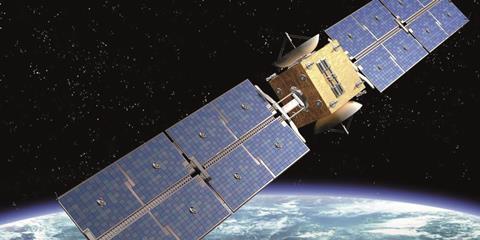Honeywell’s space business is becoming more international and nimble, as new players in the satellite communications market demand smaller and lighter components in higher volumes. Its leader Mike Elias explains
Honeywell’s involvement in space goes back to the race to the Moon in the 1960s, and the company’s technology has been on board every programme involving the USA since, including the Space Shuttle and the International Space Station. While Honeywell is well known as a provider of the on-board connectivity in the skies made possible by satellites, it has also helped usher in the satellite age itself. Some 80% of the satellites ever launched in the West use Honeywell products to steer, keep stable, communicate, and navigate. Honeywell has also equipped many of the launchers that took those satellites into space.

The Honeywell space business is spread across seven locations in Arizona, Florida and Minnesota, as well as two sites in Canada and two in the UK. It may not manufacture the launchers or the satellite buses themselves, but the company is a leader in next-tier technologies such as inertial control systems, control momentum gyroscopes, reaction wheel assemblies, command and datalink services, and strategic radiation hardened devices. On the payload side, it provides equipment such as multiplexers and ferrite switch networks. “We’ve had an unparalleled success rate over several decades,” says Mike Elias, Honeywell’s vice president for space.
However, speaking from the Honeywell space headquarters in the Phoenix suburb of Glendale, Elias acknowledges that the industry is evolving rapidly and this is driving Honeywell to alter its approach. “Space has changed drastically over 10 years,” he says. “The cost of launching satellites is dropping fast and that is disrupting everything. It used to cost half a billion dollars to launch a satellite, so you had to put everything on it. Now you can launch 20 satellites for half that cost, and the business model changes drastically. The satellite doesn’t need to last so long, and this encourages spiral development.”
One solution has been to create a “Greenhouse” – an incubator where engineers are encouraged to think creatively and develop rapidly new low-cost small satellite technology, empowered to be agile, along the lines of a Silicon Valley start-up. Honeywell has chosen as the location the former Com Dev business in Ontario that it acquired in 2016. The idea, says Elias, is that products developed there can be offered to an emerging market, as well as scaled up for use on larger satellites.
There is also a challenge of evolving the approach in the Honeywell space business, admits Elias. “With legacy platforms, the customer requirement has always been that the quality has to be perfect, as they are so expensive. Development takes a long time. With small satellites, requirements differ and you can design something that doesn’t necessarily have to last 15 years. Maybe five years is sufficient,” he says. “That way you can be faster to market. It’s a question of changing that DNA, and then getting the rest of the organisation to think in a different way.”
The Greenhouse has around 25 direct employees who work within the larger Canadian operation, which has facilities in Ottawa and Cambridge and produces the likes of passive microwave equipment and optical systems. Early projects for the incubator have included inter-satellite links, reaction wheels and optical imagers. In some instances, the mission of the Greenhouse is to take existing technology – or leverage on developed technology – and come up with ways to commercialise it for volumes needed in the constellation market.
Another way Honeywell’s space business is changing is that it is becoming more global. “Ten years ago, everything was based on a US ultimate customer. Now, it’s much moreinternational,” says Elias. “We are dealing with countries such as Canada, Germany, India, Japan and South Korea. That’s a big shift. The mentality of the customer is also changing. It used to be that customers expected everything built to the standard of a military satellite. Over the past 10 years, customers have been increasingly asking where the value is.”

Technology has been advancing fast, with operators now looking for optical inter-satellite communications, rather than simply platforms that transmit to and from the ground. “With new constellations, they need to talk to each other, when they are over water for instance. That means you need some sort of linkage to create a sort of internet in space,” says Elias. “That is where our optical or laser communications using telescopes comes in. We are proving the front-end for that technology plus the communication stream, and we are the first ones coming to market.”
While the market is expanding, customers are looking for less cost. “Today, these optical comms are very complex, heavy and costly. The operators of these new constellations are looking for units that are a multiple order of magnitude better, but for a fraction of the price,” says Elias. A proven industrial heavyweight like Honeywell is better prepared to deliver the right quality of equipment on time, says Elias. He adds: “Our technology is better than anyone’s, but we have to bring the cost to where the customers want it.” Honeywell’s response is to approach the global supply chain and “challenge them to do things differently”.
The changing industry is bringing new investors and providers into the market, encouraged by lower barriers to entry and a rising demand for low-cost, smaller satellites. “There have been roughly 8,000 satellites launched since the 1960s,” says Elias. “There could be 20,000 in the next few years.” As well as the technologies themselves, Honeywell’s strength is that, as a volume manufacturer, “we know how to scale products and take them to market”, he says.
The Honeywell space business of the 2020s is not the organisation it has been, insists Elias. “We are much more agile and much more cost-competitive, and yet we maintain the quality of our products and our portfolio is so large that we provide unique value. We are a very nimble business and able to attract some of the best talent in the world,” he says. “If you think you know us, I would urge you to take another look.”
This content was paid for by Honeywell and created in association with FlightGlobal
Reinventing Honeywell
- 1
- 2
- 3
- 4
- 5
- 6
- 7
- 8
- 9
 Currently reading
Currently readingSpace’s new faces
- 10
- 11
- 12
- 13





















































